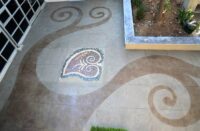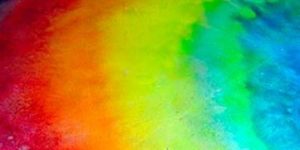Do you really understand how the products you use on your decorative projects work? The first step of my “Seven Basic Steps to Consider Before Starting Any Concrete Project” states that you should “understand the products and process.” Using the product is not enough. You have to really know what it is, what it’s made of, how it works, and how to properly use it.
In today’s hypercompetitive world, with media, advertising and so many options coming at you from all directions, following this rule can be confusing and just plain hard to do. I find that the concrete stains and dye market is one of the most competitive in our industry. Seemingly every manufacturer has them, and in some cases stains or dyes are the only product a company may be selling. Each product has a story as to why it is better, greener and easier to use than everything else on the market. So, with so many choices, how do you decide which stain or dye is best for you?
Or, maybe you’re the guy or gal who buys a specific product because it’s what you have used for years, it’s what’s available locally, or you have never had a problem — never mind that you have no clue what it’s made of and how it really works.
When it comes to concrete staining, in most cases, the job and your paycheck are riding on the final color, tone and look created by the stain. It’s important that some time be spent learning about the products you use to make a living.
Let’s start with the basics. Stains and dyes are penetrating products by definition. This automatically eliminates the cheap imitators that call themselves stains but in essence are colored coatings or colored sealers. Be wary of these cheap imitators, as they will use the buzzwords “stain” and “penetrating” but form a film on the job. If it requires an acid etch prior to application, it is probably not a true stain. True stains do not form a film and can range from opaque to translucent.
In regard to composition, all stains and dyes are comprised of the same core components: a carrier (liquid) and a colorant (pigment or dye). There are other ancillary ingredients that can be added to enhance performance, but the two core elements remain the liquid carrier and the colorant. With that piece of information in place, we can now look at how different carriers and colorants offer different outcomes and why you would use one over another depending on the project.
The carrier (liquid)
In the most simplistic way, the liquid carrier allows us to get the colorant from the bottle to the floor. It “carries” the colorant and allows it to penetrate into the substrate. Visualize the liquid carrier giving the colorant a piggyback ride into the concrete. Once the carrier has completed its job of carrying the colorant, it is free to go away — and this is exactly what it does. In most cases it evaporates, with some carriers moving on to perform other functions such as hardening the substrate.
Here are some common stain carriers and their key attributes.
Water: Cheap, easy to access, no odor, high surface tension, requires a porous surface.
Acetone: Costly, high odor, high flammability, low surface tension, penetrates very dense tight surfaces, fast-drying.
Alcohol: Cheap, low odor, medium flammability, low surface tension, penetrates dense and tight surfaces, dries at medium speed.
Penetrating sealers: High cost, low odor, medium surface tension, requires a porous surface.
Some stains will use a blend of these carriers to gain the benefits of different liquids. Since these are all “simple solvents,” they are miscible, meaning they can be mixed together.
The colorants (pigment or dye)
There are two different common colorants used in decorative coloring products — pigments and dye. The difference between the two is that a pigment is insoluble in the carrier liquid (resulting in suspension), and a dye is soluble in its carrier liquid (resulting in a solution). Without getting into too much chemistry, the important factors to consider and be aware of with stain colorants are color palette, solubility, particle size and UV stability. The bigger the particle size, the more porous the substrate needs to be, while small-particle colorants can squeeze into tight spaces and dense substrates. Here are some common colorants and their key attributes:
Mineral salts: Metal-based, large particle size, found in acid stains, deep earth-tone colors, limited color palette, react with cement-based materials to become permanent, some may have toxicity issues, UV-stable.
Organic pigments: Vivid colors, wide color palette, large particle size, some UV stability, no toxicity issues.
Inorganic pigments: Metal-based, limited color range, large particle size, excellent UV stability, some toxicity issues.
Dyes: Metal-based and organic, wide color range, bright colors, very small particle size, poor UV stability, no toxicity issues.
Pigments dispersed in acrylic resin: Organic and inorganic, wide color selection, large particle size, good UV stability, no toxicity.
We now have a better understanding of the makeup of stains and dyes, so let’s look at some choices.
If color palette is important, organic and acrylic colorants used in water-based systems make sense. The down side with these is their large particle size requires a very porous surface for them to gain penetration.
If UV stability is important, look for metal-based or inorganic colorants that will stand up to the harshest UV rays. If penetrating a dense, hard surface is important, lean toward dyes in alcohol or acetone (or a blend of the two) to get into those tight surfaces. Dyes in acetone have become the staple colorant for polished concrete.
Also keep in mind that water, while being the cheapest and most widely available carrier, also has the highest surface tension and will tend to float on the surface if it’s overapplied or if the surface is too tight or dense.
In my experience, all the stains and dyes on the market work. What your choice comes down to is understanding the product makeup and then matching the right stain to the surface or substrate you are working with on your particular project. As always, the most important step is to perform job-site samples or mock-ups. Since every concrete substrate is different, sampling on the actual floor to be stained is the best way to predict the final outcome.















